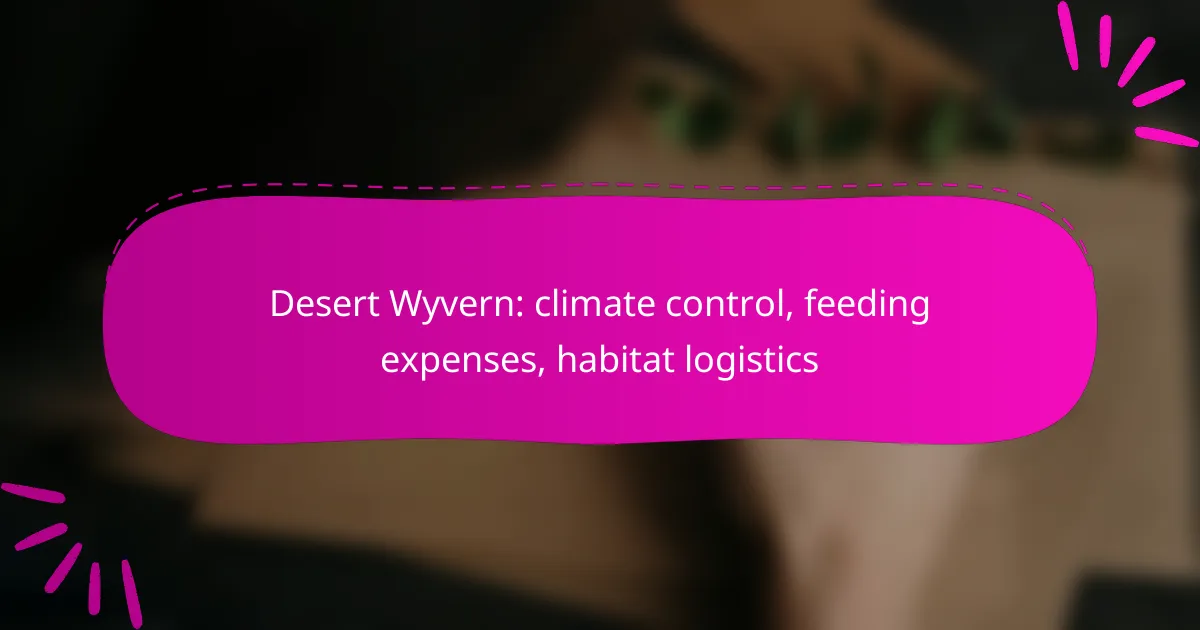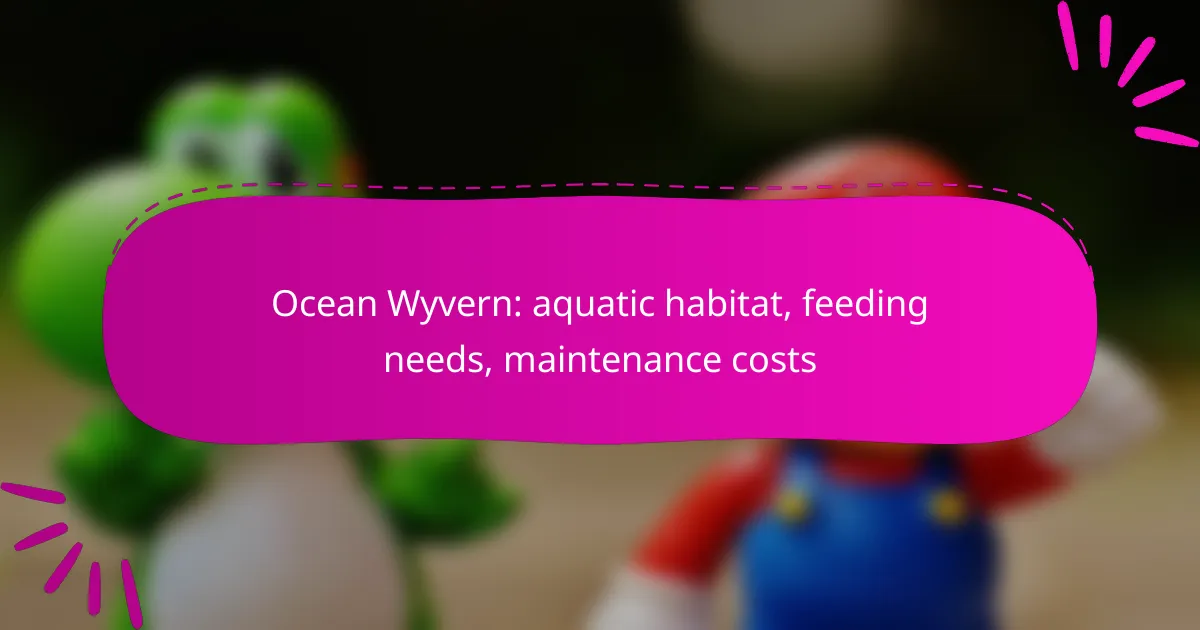Desert Wyverns thrive in carefully managed environments that replicate their natural habitats, emphasizing temperature, humidity, and seasonal variations. Effective climate control not only supports their health but also helps reduce feeding expenses and streamline habitat logistics. Owners must consider specialized diets and adequate space, along with environmental enrichment and water management, to ensure these majestic creatures flourish in captivity.

How to manage climate control for Desert Wyverns?
Managing climate control for Desert Wyverns involves creating an environment that mimics their natural habitat, focusing on temperature, humidity, and seasonal changes. Proper climate control ensures the health and well-being of these creatures while minimizing feeding expenses and habitat logistics challenges.
Temperature regulation systems
Temperature regulation is crucial for Desert Wyverns, as they thrive in warm environments. Implementing systems such as heat lamps or radiant heating can maintain optimal temperatures, typically ranging from 25°C to 35°C (77°F to 95°F). Regular monitoring with thermometers is essential to prevent overheating or chilling.
Consider using programmable thermostats to automate temperature adjustments based on the time of day. This can help simulate natural temperature fluctuations, which can be beneficial for the wyverns’ behavior and metabolism.
Humidity control methods
Desert Wyverns require specific humidity levels to stay hydrated and healthy. Maintaining humidity between 30% and 50% is ideal, which can be achieved through misting systems or humidifiers. Regularly check humidity levels with hygrometers to ensure they remain within this range.
Be cautious not to over-humidify, as excessive moisture can lead to health issues. A balance can be struck by using a combination of water sources, such as shallow bowls for drinking and misting for environmental humidity.
Seasonal adjustments
Seasonal adjustments are necessary to replicate the natural climate variations that Desert Wyverns experience. During hotter months, increase temperature and humidity slightly, while in cooler months, lower both to reflect seasonal changes. This mimics their natural habitat and promotes healthy behaviors.
Plan for these adjustments ahead of time, ideally transitioning gradually over a week. This helps the wyverns acclimate without stress. Additionally, consider seasonal dietary changes that may align with their natural feeding habits during different times of the year.

What are the feeding expenses for Desert Wyverns?
The feeding expenses for Desert Wyverns can vary significantly based on their diet and habitat. On average, owners should budget for specialized feed, which can be a substantial part of their overall care costs.
Cost of specialized feed
Specialized feed for Desert Wyverns typically includes high-protein pellets, fresh meat, and occasional fruits or vegetables. Monthly expenses can range from a few hundred to over a thousand USD, depending on the quality and quantity of feed required. It’s essential to source feed from reputable suppliers to ensure nutritional adequacy.
Feeding frequency
Desert Wyverns generally require feeding every 2 to 3 days, with younger wyverns needing more frequent meals. This schedule helps maintain their energy levels and supports healthy growth. Owners should monitor their wyvern’s weight and adjust feeding frequency accordingly to prevent obesity or malnutrition.
Supplemental nutrition options
In addition to specialized feed, owners can consider supplemental nutrition options like vitamins and minerals to enhance their wyvern’s diet. These can be particularly beneficial during breeding seasons or when the wyvern is under stress. Always consult a veterinarian before introducing new supplements to ensure they meet dietary needs.

What habitat logistics are necessary for Desert Wyverns?
Desert Wyverns require specific habitat logistics to thrive, focusing on adequate space, environmental enrichment, and effective water source management. These elements are crucial for their well-being and successful adaptation to their environment.
Space requirements
Desert Wyverns need ample space to roam and exhibit natural behaviors. A minimum enclosure size of several hundred square meters is recommended, with vertical space for climbing and perching. The enclosure should be designed to mimic their natural habitat, allowing for both open areas and shaded spots.
When planning the space, consider the number of wyverns and their social dynamics. Overcrowding can lead to stress and aggression, so ensure that each wyvern has sufficient room to establish its territory.
Environmental enrichment
Providing environmental enrichment is essential for Desert Wyverns to prevent boredom and encourage natural behaviors. This can include climbing structures, hiding spots, and interactive toys that stimulate their hunting instincts. Rotating enrichment items regularly keeps the environment engaging.
Consider incorporating elements that replicate their natural surroundings, such as sand pits or rocky outcrops. This not only enhances their habitat but also supports their physical and mental health.
Water source management
Water source management is critical for Desert Wyverns, as they require access to clean water for hydration and bathing. A reliable water source, such as a shallow pool or misting system, can help maintain humidity levels and promote health. Ensure that water is changed frequently to prevent contamination.
Monitor the water quality regularly, as stagnant water can lead to health issues. Consider using filtration systems if the habitat is large, and provide multiple water access points to accommodate all wyverns comfortably.

What are the best suppliers for Desert Wyvern habitat materials?
Choosing the right suppliers for Desert Wyvern habitat materials is crucial for creating a suitable environment. Focus on local suppliers and reputable online retailers to ensure quality and availability of necessary materials.
Local suppliers in the USA
In the USA, local suppliers often provide specialized materials for Desert Wyvern habitats. Look for garden centers or pet supply stores that cater to exotic animals. These suppliers typically offer substrates, plants, and climate control equipment tailored for desert environments.
Consider visiting trade shows or expos focused on reptiles and exotic pets, where you can find vendors specializing in habitat materials. Establishing a relationship with local suppliers can also lead to discounts and access to bulk purchasing options.
Online retailers for habitat supplies
Online retailers offer a wide range of habitat supplies for Desert Wyverns, often at competitive prices. Websites like Amazon, Chewy, and specialized reptile supply stores provide everything from heating lamps to substrate materials. Ensure you check customer reviews to gauge the quality of products before purchasing.
When ordering online, factor in shipping costs and delivery times, especially for larger items. Some retailers may offer free shipping on orders above a certain amount, which can help reduce overall expenses.

How to ensure compatibility with other species?
Ensuring compatibility with other species involves understanding their behavioral traits and spatial needs. Proper assessments and guidelines can help create a harmonious environment for all inhabitants.
Behavioral assessments
Conducting behavioral assessments is crucial for determining how different species interact. Observing feeding habits, social structures, and territorial behaviors can provide insights into compatibility. For example, species that are naturally aggressive may not coexist well with more docile ones.
It’s beneficial to monitor interactions over time, as initial observations may not reveal long-term compatibility. Regular assessments can help identify stress signals or aggressive behaviors that may arise as species acclimate to shared habitats.
Space sharing guidelines
Space sharing is essential for maintaining peace among different species. Each species has unique spatial requirements, and it’s important to provide adequate room to minimize territorial disputes. For instance, larger species may need more space to roam compared to smaller ones.
Establishing designated areas for each species can help reduce competition for resources. Consider using barriers or natural dividers to create separate zones while allowing for visual contact, which can help ease tensions. Regularly reassess these spaces to ensure they meet the evolving needs of all species involved.

What are the common health issues for Desert Wyverns?
Desert Wyverns often face health challenges primarily due to nutritional deficiencies and environmental stress factors. Addressing these issues is crucial for their well-being and longevity.
Nutritional deficiencies
Nutritional deficiencies in Desert Wyverns can lead to serious health problems, including weakened immune systems and stunted growth. A balanced diet rich in proteins, vitamins, and minerals is essential to prevent these deficiencies.
Common dietary needs include high-quality meats and specialized supplements to ensure they receive adequate nutrients. Regularly assessing their diet can help identify any gaps and allow for timely adjustments.
Environmental stress factors
Environmental stress factors significantly impact the health of Desert Wyverns, particularly extreme temperatures and inadequate habitat conditions. These creatures thrive in specific climates, and deviations can lead to stress-related illnesses.
To mitigate environmental stress, ensure that their habitat maintains stable temperatures and humidity levels. Providing shaded areas and proper ventilation can help reduce heat stress, while regular monitoring of their living conditions is vital for their health.

What emerging trends are shaping Desert Wyvern care?
Desert Wyvern care is increasingly influenced by advancements in habitat technology, climate control, and feeding management. These trends focus on creating optimal living conditions while minimizing costs and logistical challenges.
Innovations in habitat technology
Recent innovations in habitat technology for Desert Wyverns include automated climate control systems and advanced enclosure designs. These systems can regulate temperature and humidity, ensuring a stable environment that mimics their natural habitat.
For example, smart thermostats and humidity sensors can be integrated into enclosures, allowing for real-time adjustments based on the Wyvern’s needs. This not only enhances the animals’ well-being but also reduces energy consumption, leading to lower operational costs.
When implementing these technologies, consider the initial investment versus long-term savings. While upfront costs may be significant, the efficiency gains can lead to substantial reductions in feeding expenses and maintenance over time.










